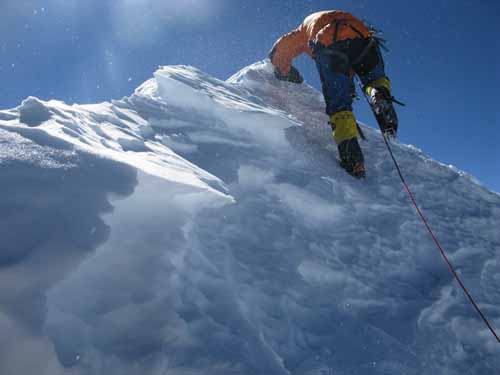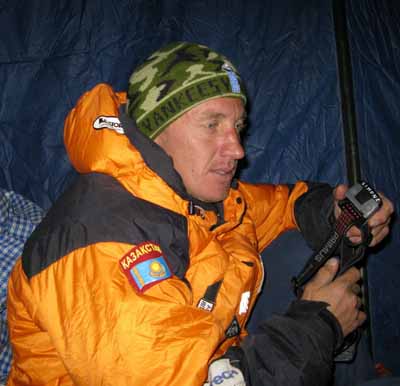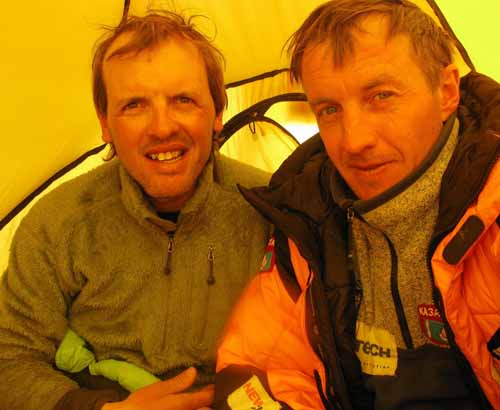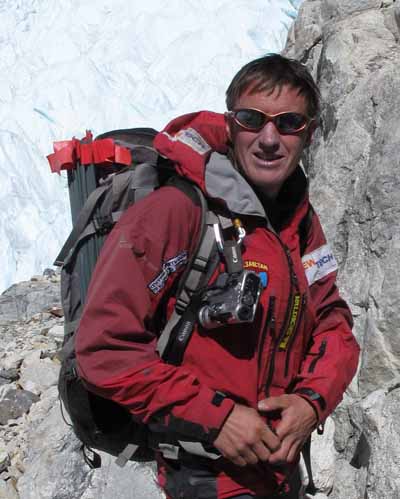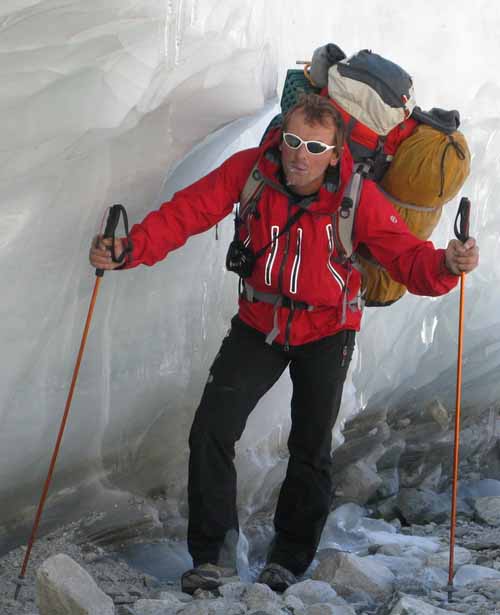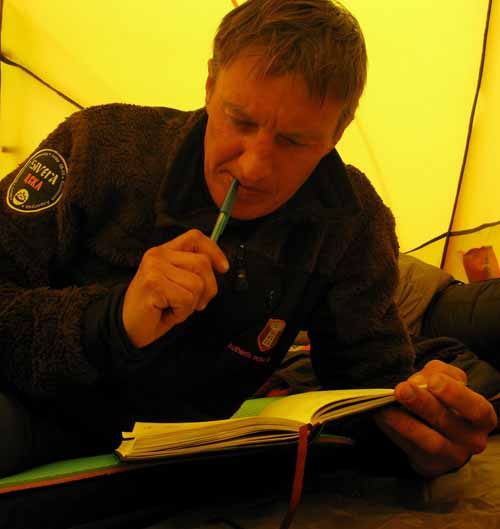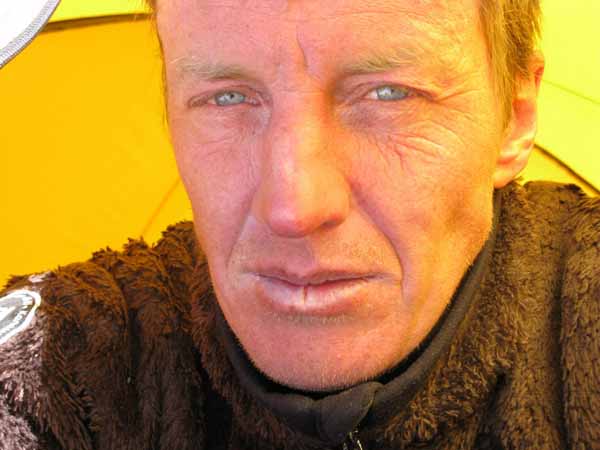

Denis Urubko (Almaty, Kazakhstan) "We came to the right place in the right time..." Interviw for Russianclimb.com and ExWeb about the first Makalu winter climb. January-February 2009 Sponsors: Central Sport Club of Kazakhstan Army,
Russianclimb: Makalu in 2009 is your 16th 8000-er. Do you remember, as nine years ago you arrived to Himalaya for the first time? As you looked at those huge peaks and thought about those famous climbers, who climbed Himalaya tops? The first impressions are usually so bright… The new perception is gradually erased. What does excite you, when you come to the Himalaya and Karakorum now? - Well, of course, everything is not like in the beginning. But I see the mountains, first of all, as an athlete. Aesthetics is in the second term. The more I go on 8000-ers, the more opportunities open to me, I see more the potential routes, a lot of them, and very interesting. I now see that was not previously noticed. For example, I looked at Lhotse in those days, and saw a huge mountain for the climb. And now I look at it from this hand, and that, and plan how to make the non-trivial climb. I climb and climb mountains, but there’s more and more novelty in that sense. Russianclimb: Do you think you are lucky on Makalu this year? - Yes. Not only one moment of luck, but in a complex of factors. We have well-managed all, and came to the right point at the right time. In this regard, we are more fortunate than all the previous winter Makalu expeditions.
ExWeb: What’s the difference of this climb from the last winter Makalu climb? - This winter was warmer, the wind was another. Last winter, it was mainly West, South-West, and this year North-West and North. There was no such huge frazils and terrible hummocks on the lakes. The weather was generally good. But when we descended to the base camp after the climb, the heavy snowfall just began, so the Base Camp became to be covered with thirty centimeters layer of the snow. Simone and me were trained so well, that had the excellent athletic shape. I knew the route well, planned the time of departure, but every time we actually came to the place 2-2,5 times faster. This expedition was easier for me, because of the absence of liability pressing. Last winter, I was worry for the mates, who were not experienced enough in high-altitude climbs. And here we are with Simone, two soldiers, two gladiators…
The last step to Makalu summit Russianclimb: What can you say about the belief in the partner? - I know Simone for a long time, and he knows me. We are just sure that none of us leaves the other, no matter what happened. We’ll crawl, but not leave the partner, try to rescue him. Well, we are sure in the technique experience of each other, the professionalism, endure ability ... Plus, we know each other’s capabilities. I would never do such climb with the unknown partner. The simple high-altitude route – OK, I can climb with everybody. But winter Makalu climb above 7400 m is like you go on a stretched rope at altitude. Any, even the most minor error, tiny wrong move will lead to the deaths of both. You can’t climb here without the absolute belief in the partner. In 2004, on Annapurna we climb simultaneously with Simone on front crampons tooth via the dangerous snow field. That could be done only in the absolute belief in each other. And now, between 8100 m and 8200 m, where was the entry under the rocks, the snow has been blow out, and fixed ropes had been blow out by the wind, and we had only the last short rope for the belay. And again we had to go simultaneously.
Denis on the top
Simone on the top Russianclimb: Pablo Ochoa de Olza (Inaki’s brother) wrote in his letter: "These two extraordinary men have once again shown what they are made of. Made of the same rock as the Himalayas, of the same spirit as the wind, of the same nature as steel. What they achieved in Makalu will be correctly measured in some decades, when it really becomes obvious the impossible quest it is." Did you feel, that you that you pushed the limits of the possible, or you just gently did a professional job? - We worked as the professionals. The professionals are those who work within the framework of consistent excellence. There mustn’t be any situations where we couldn’t understand what to do. But in the last year winter Makalu expedition – yes, it was a feeling that we were on the edge of possibilities. Serguey Samoilov was sick and Eugeny Shutov did not have sufficient experience, and the weather was just terrible.
Russianclimb: Last time you were four in the team in the winter, and now are only two. What is preferable? - Four-members team is safer. If someone is hurt, there are more chances to rescue him, but it is about impossible in duo. But psychologically it’s more comfortable if you are only two. You are always in an equal position, one by one. And even in trio there’re always three different divisions, and always one against other two, and then another one, who is against the other two. This is straining in vain. And, of course, in the large teams there is always enough of conflict, particularly in lengthy expeditions. Russianclimb: You may have read in the base camp that the media writes about you during the winter expedition? - Simone received the news that Messner in the last review in a popular Italian newspaper wrote that mountaineering developed not so successfully in recent years, but Simone and Denis are involved with a real mountaineering. Of course, I was shocked (in a positive aspect (Denis smiles) by those words. It was important for us, too, that Mario Kurnis ( he’s also from Bergamo), our great friend, who did the very first attempt on Makalu winter along with Renato Kazarotto in 1980, went with Simone to the airport before the expedition, and he had a premonition that we would be OK. Although Mario himself had very severe memories from the 1980 expedition. Russianclimb: Perhaps the most fundamental skill, which should have someone who’s going to the winter Makalu, is patience? In the base camp the air is constantly fill in hanging dust, very little-size sand flies on the wind, and they are with mica, and this sand penetrate into the lungs. We had to hawk for a long time, it was very difficult.
Russianclimb: How did you divide acting? What kind of food did you take to altitude? Russianclimb: Did you find some of your ropes, left in the last spring? - Not only ours, not only from the last spring. We have found old (older than 5 years) ropes, and used them, cut and fixed on the route. Russianclimb: How do you think, what’s happened with Jean-Christophe Lafaille in 2006? He’d missed since the night in 7500 somewhere? - Most likely, he was blown out by the wind. It’s too easy at 7500-7600 m. There are the long flat ice slopes. If you sleep, without the belay, you’d fall down 800 meters, but there’re rocks already… Or on the rocks just below the summit – very dangerous place, you can loose the coordination and fall. Russianclimb: How difficult was the filming on the route? - Very hard. I tried, but hadn’t invented a suitable way of wearing the camera. I carried it around my neck, but, though a little, the neck was pressed. This hindered at the altitude. Really, the camera is hidden deep in the clothing against being frozen. Each time I struggled against my sloth. I put off the gloves when made pictures, but didn’t put off the mittens.
Russianclimb: Could you communicate with your beloveds and friends during the climb? - Yes, we had unlimited traffic. Simone talked a lot with the daughter Martina, with Barbara, I was able to call to my children. It was great support for us, of course! Russianclimb: What were the realities of life in the base camp? - In the base camp we had a large stove, which we bought in Kathmandu. And in the very beginning out life in BC we had been poisoned by it, very hard. We had to recover during the whole day. And we didn’t use it then. One night the wind gust had blown out my tent at the base camp, cut two ropes. The tent had been turned out, all things in a heap, and I was inside, half-sleeping, floundering... And it happened at the foot of the mountain! I had to get out in the windstorm, set the tent, strengthen it... And Simone’s large tent stood steadfast, he set and strengthened it so good together with cooks! But the next night it laid down directly on Simone, and nothing could be done to correct the tent. Of course, he could not sleep. Just the night before he got that long-awaited modem. So Simone sat down at the computer, and worked throughout the night. And the tent laid on him. By 5 am the wind died ... And Simone fell asleep. Russianclimb: Did you feel scared too when worked at the route? - No, it was easy there. You’re busy, and your imagination is off. So, you don’t feel so scared…
Russianclimb: Which moment of the climb was the most difficult? - The foresummit crest. It was very hard. I almost died there. I had to pull ropes out of firn ... And, every step was a problem: it was necessary to "punch" the snow ... and I have no energy already ... Russianclimb: Last winter, on your and Samoilov summit bid, you decided to turn back not far from the top. How did you feel what’s the limit? What did define a "point of return"? - You know, this is the feeling, which is developed by the experience, it is already intuitively ... This feeling is like you hand the stretched gum, and it stretches, stretches, and then - stop, then it can burst. So, it’s necessary to turn. And sometimes the gum stretches, stretches, it looks like a limit, but I feel the tiny opportunity to stretch it more - then I will continue to go up. There’re a lot of factors determining the "point of return": the weather, the health, the limit of patience, the experience of guys who climb with you, whom you are responsible for, the unknown further route… ExWeb: What about your plans? - It is very important for me to help the young climbers, who see the mountaineering like a sport, to help them to find their own way, to determine some objectives, and realizations in the mountains. Therefore, I do and will do the best for the preparing the young team. As for myself, I will seek more and more sense of novelty on the beautiful lines at high-altitude. I’ll try to implement the projects 8000-ers climbs via the new difficult routes (if I’ll have enough power). But often not only the route, but the very summit, can become the goal, so I would climb normal routes with the young team.
ExWeb: What do you think about winter Broad peak climb? -It’s very interesting project, of course! But I’m not ready for such extreme jerk. I climbed Broad peak twice, and I managed my first great 8000 climb there via new interesting route. And I’m not ready to do something the same level there. It was too hard in 2005. Russianclimb: Are you going to write the book about Makalu? - Yes, I’ll write about my three Makalu expeditions. I’ll write all in details. You know, I write the diary in every expedition, and all three Makalu diaries are in this one notebook. Hope, the book will be ready by the end of the year. And now I have to publish the next book with my articles… Russianclimb: Here we look at the pictures: Piotr Kuznetsov, Inaki, Vladimir Arkhipov ... You sigh: "The best climbers lost in the mountains..." Does the chain of those tragedies cause the increase of the constant psychological pressure? - Yes, of course. I remember always about them. And don’t think that nothing will happen with me. But to some extent, this memory helps me, because it makes me more attentive to my actions, asks not to risk without circumstances, be prepared better, to analyze the situation and other climber’s mistakes more carefully. Therefore, when truly good experienced climbers died, those are tragedies, but from the other hand, it’s the help to survivors: be careful!
the descent Russianclimb: When choosing a new route, you simply follow your dream, or it is important to you, how this line will be adopted in the world climbing community? - I choose the route listening to my soul. Usually, I notice some interesting line, and after a few years I find the opportunity to climb this route. Thus was born the idea of the first climb Broad Peak SW Face, and K2 North ridge (heaven forbid, we’ll climb it!), and Eight Women climbers peak…The last line is on so beautiful yellow wall! It’s so beautiful, that you can’t tear off a sight! If I seek for PR, I’d better prefer to climb Khan Tengri North Face – there’re so many routes, but 5 meters left – 5 meters right – and you can climb the new route, and it will be prestigious. But Eight Women climbers Peak – it’s like a song, but not everybody understand, how cool it is. In the future, I still will choose the routes, which the soul craves.
Russianclimb: What were you passionately dreamed about during the expedition, beside of the summit? - About glazed cheese! (said under officer Urubko, deploying next cheese :)
Questions by Elena Laletina and Tina Sjorgen. March,19, 2009 |


